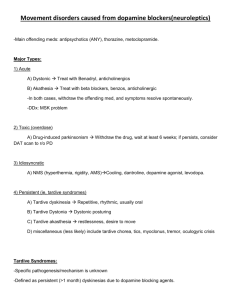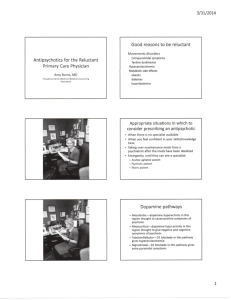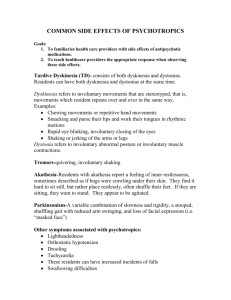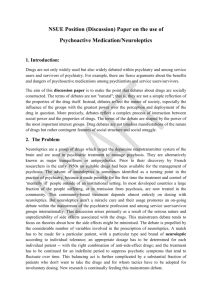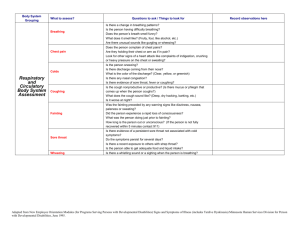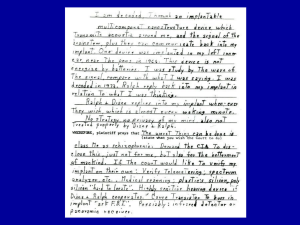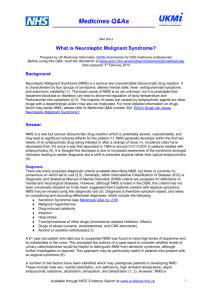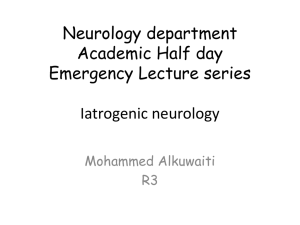Brain-Disabling Treatments in Psychiatry
advertisement
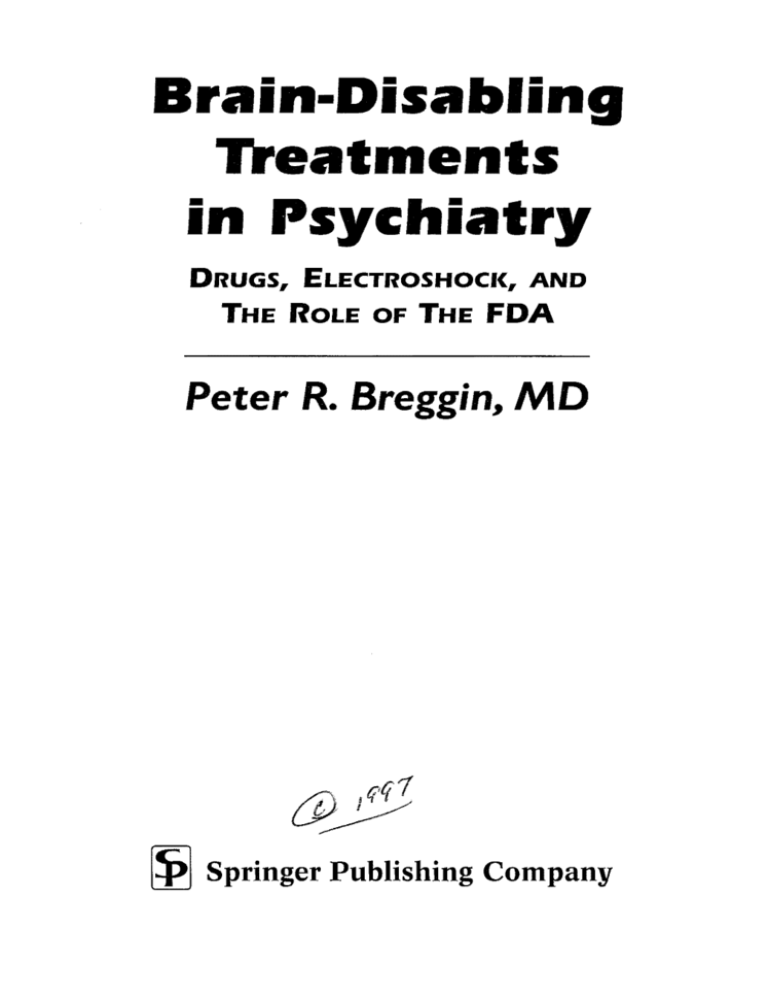
Brain-Disabling Treatments in Psychiatry DRUGS, ELECTROSHOCI(, AND THE ROLE OF THE FDA Peter R. Breggin, MD /7). /;ltj1 LY~ [~I Springer Publishing Company Contents Introduction and Acknowledgments ...... ... ... ........ ............. ..... ..... .......... xi 1 The Brain-Disabling Principles of Psychiatric Treatment ............................................................... 1 2 Deactivation Syndrome (Chemical Lobotomy) Caused by Neuroleptics ............................................................... 14 3 Neuroleptic-Induced Anguish, Including Agitation, Despair, and Depression .............................................................. 25 4 Neuroleptic Malignant Syndrome, Tardive Dyskinesia, Tardive Dystonia, and Tardive Akathisia ....... ......................... 35 5 Neuroleptic-Induced Brain Damage, Persistent Cognitive Deficits, Dementia, and Psychosis .............. ...... ........ 53 6 Antidepressants, Including Prozac-Induced Violence and Suicide .................................................................................... 77 7 Lithium and Other Drugs for Bipolar Disorder .................... III 8 Electroshock for Depression ..................................................... 129 9 Stimulants and Other Drugs for Children, Including an Analysis of Attention-Deficit Hyperactivity Disorder ...... 157 10 Antianxiety Drugs, Including Behavioral Abnormalities Caused by Xanax and Halcion ., ...... ......................................... 184 ix x Contents 11 Drug Companies and the Food and Drug Administration: Failed Mandates ............................................ 208 Bibliography . ... ... ... ... ... ......... ...... ...... ...... ...... ...... ....... ...... ....... ...... ...... 234 Index ................................................................................................... 295 CHAPTER 4 Neuroleptic Malignant Syndrome, Tardive Dyskinesia, Tardive Dystonia, and Tardive Akathisia This chapter focuses on two well-known neurological disorders caused by the neuroleptics-tardive dyskinesia (TD) and neuroleptic malignant syndrome (NMS), with emphasis on their frequency and their destructive impact on the physical and emotional life of the individual. It also discusses neuroleptic withdrawal syndrome. The next chapter will explore irreversible damage to the brain that primarily affects mental functioning, including tardive psychosis and tardive dementia. However, as products of neuroleptic neurotoxicity, all these drug-induced abnormalities are clinically and neurologically interrelated. TARDIVE DYSKINESIA Within a few years after the development of the first neuroleptic, it became obvious that many patients were not recovering from their drug-induced neurologic disorders even after termination of the therapy. Reports were made in the late 1950s. Delay and Deniker (1968) date their awareness 35 36 Neuroleptic Malignant Syndrome and Relnted Disorders of irreversible neurological syndromes to 1959. By 1968 they were able to provide a vivid review of several varieties, including buccolingual, tnmcal, and variable choreic movements. In 1964 Faurbye (Faurbye, Rasch, Petersen, & Brandborg, 1964) named the disorder tardive dyskinesia. As if governed by one mind, psychiatry as a profession refused to give any official recognition to this potential tragedy. Then Crane made it a personal crusade to gain the profession's recognition of the problem (1973). The American College of Neuropsychopharmacology/Food and Drug Administration Task Force (1973) described the syndrome in a special report. Following 1973, everyone in the profession should have been alerted to the dangers of TD; but too many psychiatrists have continued to act as if it hardly exists. In 1980, the American Psychiatric Association (APA) published a task force report on TD. In 1985 the FDA took the unusual step of setting specifically worded requirements for a class warning in association with all neuroleptic labeling and advertising ("Neuroleptics," 1985). In a wholly unprecedented move, in the same year the APA sent out a warning letter about the dangers of tardive dyskinesia to its entire membership (see chapter 11 for further discussion of the FDA's role). TD often begins with uncontrolled movements of the face, including the eyes (blinking), tongue, lips, mouth, and cheeks; but it can start with almost any group of muscles. The most common early sign is a quivering or curling of the tongue. Tongue protrusions and chewing movements are also common, and can become serious enough to harm teeth and impair chewing and swallowing. The hands and feet arms and legs, neck, back, and torso can be involved. The movements displayed are highly variable, and include writhing contortions, tics, spasms, and tremors. The person's gait can be badly impaired. More subtle functions can be affected and are easily overlooked: respiration (involving the diaphragm), swallowing (involving the pharynand esophageal musculature), the gag reflex, and speech (Yassa & Jones, 1985). The movements usually disappear during sleep, although I have seen exceptions. They sometimes can be partially suppressed by willpower; frequently are made worse by anxiety; and can vary from time to time (see below). Many cases of TD appear to be relatively mild, often limited to movements of the tongue, mouth, jaw, face, or eyelids. Nonetheless, they are Brain-Disabling Treatments in Psychiatry 37 frequently disfiguring and often embarrassing. Patients have been known to commit suicide (Yassa & Jones, 1985). The abnormal movements can sometimes become totally disabling. Turner (1971) describes patients who cannot eat and must have their teeth removed in order to facilitate the entry of food into their mouths. He also describes patients who cannot keep shoes on their feet because they wear them out while sitting with the constant foot-shuft1ing activity. I have evaluated a number of cases in which the tardive dyskinesia was wholly disabling, including massive distortions of the position of the neck or body, rocking and swaying, shoulder shrugging, and rotary or thrnsting movements of the pelvis, as well as disturbances of respiration, such as periodic rapid breathing, irregular breathing, and grunting. Ironically, the disease makes the patient look "very crazy" because of the seemingly bizarre facial and bodily movements. Tragically, this has often led to patients being treated more vigorously with neuroleptics, ultimately worsening their TD. As in other neurological disorders, the patient may attempt to hide the disorder by adding voluntary movements to the involuntary ones in order to disguise them. For example, to cover up a tendency to move the arms continually, the patient may make grooming movements around the face and hair. This can make it seem as if the individual suffers from a psychological compulsion instead of a neurological disorder. Or the patient may clasp his arms together in order to control the movements, making it seem as if he is trying to psychologically "hold onto himself." All the neuroleptics (see chapter 2 for a list) can cause tardive dyskinesia, including the atypical neuroleptics clozapine (Weller & Kornhuber, 1993) and risperidone (Addington, Toews, & Addington, 1995). The overall adverse effects of the atypical neuroleptics are summarized in chapter 5. Masking the Symptoms of TD with Continued Neuroleptic Treatment The symptoms of tardive dyskinesia are masked or suppressed by these drugs, so that the disease symptoms do not fully appear until the patient has been removed from the treatment. For this reason, in addition to using the smallest possible dose for the shortest possible time, whenever possible patients should periodically be removed from their neuroleptics, if only 38 Neuroleptic Malignant Syndrome and Related Disorders for a short period, to determine if they are developing tardive dyskinesia. Permanent removal from the neuroleptics is a more difficult matter, often requiring many months of gradual withdrawal for the hrain to adjust to the drug-free environment. Harold Klawans has discussed the dangerousness of trying to control or treat TD with the causative agent. He asserts (in the discussion following Goetz et al., 1980): "Treatment of tardive dyskinesia with neuroleptics themselves is clearly treatment with the presumed offending agent and should be avoided." He calls it "short-sighted" to use the neuroleptics in the treatment of tardive dyskinesia, and concludes that the therapy "serves to aggravate its pathogenesis." Unhappily, Klawans himself in the same article too readily recommends reserpine as a helpful agent in the treatment of TD, when it too can cause the disorder. Nonetheless, I have seen cases of TD that were so disabling that the only recourse seemed to be treatment with a neuroleptic. But two points must be borne in mind about these cases. First, in each instance, the case became so severe because physicians failed to detect the disorder when it first appeared and continued neuroleptic treatment long after it should have been terminated. This has been true in nearly all the most disabling cases I have examined. Second, the individuals in question were overcome with suffering and rendered wholly unable to function by the TD. They and their families made informed decisions to continue the offending agent because the TD was making life unbearable for the patient. The anticholinergic drugs typically used to ameliorate the symptoms of drug-induced parkinsonism also may aggravate the symptoms of TD (Yassa et al., 1992). They include benztropine (Cogentin), biperiden (Akineton), and trihexyphenidyl (Artane, Tremin). These agents are known to worsen similar symptoms in Huntington's chorea (Hunter, Blackwood, Smith, & Cumings, 1968; Klawans, 1973). At present the role of these drugs in the development or exacerbation of tardive dyskinesia is controversial and undetermined, but caution is required in giving them to patients on neuroleptics. Their adverse effects are discussed in chapter 2. These agents are often used to treat acute extrapyramidal symptoms and may be mistakenly prescribed for TD. Rates of TD In 1980 the APA produced a detailed analysis of the disease in its Task Force Report: Tardive Dyskinesia. It made clear that TD is a serious, Brain-Disabling Treatments in Psychiatry 39 usually irreversible, untreatable, and highly prevalent disease resulting from therapy with the neuroleptics. The task force estimated the prevalence rate for TD in routine treatment (several months to 2 years) as at least 10%-20% for more than minimal disease. For long-term exposure to neuroleptics, the rate was at least 40% for more than minimal disease. Even after the publication of the 1980 task force report and a mountain of confirmatory evidence, some biologically oriented psychiatrists, such as Nancy Andreasen (1984), in The Broken Brain: The Biological Revolution in Psychiatry, continued to misinform the public that tardive dyskinesia is "infrequent" (p. 210) and occurs in "a few patients" (p. 211). The more recent APA task force (1992) report cites a rate of 5% per year, cumulative over the first several years of treatment. Jeste and Caligiuri (1993) estimate the annual incidence rate among young adults at 4%5%. In a recent prospective project emanating from Yale, Glazer, Morgenstern, and Doucette (1993) reported a long-term evaluation of 362 outpatient psychiatric patients who were free of TD at baseline and who were being maintained on neuroleptics. For patients who are starting neuroleptics, according to projections from their data, the risk of tardive dyskinesia will be 31.8% after 5 years of exposure-a rate of slightly over 6% per year. The risk is 49.4% after 10 years, 56.7% after 15 years, 64.7% after 20 years, and 68.4% after 25 years. Chouinard, Annable, Mercier, & Ross-Chouinard (1986) followed a group of 136 persons who had already been receiving neuroleptics but had not manifested TD. Over 5 years, 35%-a rate of 7% per yeardeveloped the disorder. Overall, in relatively young and healthy patients, the cumulative risk of contracting TD when exposed to neuroleptic~ ranges from 4%-7% per year during the first several years of treatment. Approximately one-third of the patients will develop this largely irreversible disorder within the first five years of treatment. This represents an astronomical risk for patients and should become part of the awareness of all mental health professionals, their patients, and their patients' families. Furthermore, we shall find that TD brings with it the additional risk of irreversible cognitive dysfunction and dementia (chapter 5). There is evidence that rates for tardive dyskinesia are increasing. It may be caused by the growing tendency to use drugs with seemingly more toxic effects on the extrapyramidal system, such as Haldol and Prolixin (see Jeste & Wyatt, 1981). These drugs also come in long-acting 40 Neuroleptic Malignant Syndrome and Related Disorders intramuscular preparations that do not permit patients to independently lower their own dosages by taking fewer pills than prescribed. It is unusual for TD to develop in less than 3-6 months' treatment and standard texts suggest that TD which develops earlier requires special investigation. However, it is not possible to place too much emphasis on one point that has been mentioned by Tepper and Haas (1979) and others (for example, Hollister. 1976): tardive dyskinesia can develop in low-dose, short-tenn treatment. DeVeaugh-Geiss (1979) has seen cases develop in a matter of weeks. I have seen several cases develop at around 3 months of treatment. One patient developed tardive dyskinesia after 1 month of recent exposure, with a history of 2 months' prior exposure several years earlier. One case which developed in 3 months of constant exposure had a probable history of prior head injury from childhood. In the elderly, many cases may develop within a few weeks (see below). THE ELDERLY AND OTHER VULNERABLE POPULATIONS It is important to remember that medications in general are more likely to cause dysfunction in the elderly (Nolan & O'Malley, 1988). Nowhere is this demonstrated more tragically than in regard to TD. A study of elderly nursing home patients by Yassa, Nastase, Camille, and Belzile (1988) found that 41 % developed tardive dyskinesia over a period of only 24 months and that none fully recovered. While long-term studies have found a spontaneous dyskinesia prevalence of 1%-5% in the elderly, none of the non-drug-treated controls developed spontaneous dyskinesias during the 2 years. Yassa, Iskander, and Ally (1988) found TD in 45% of an outpatient clinic population with a mean age of 60. In a more recent study, Yassa, Nastase, Dupont, and Thibeau (1992) followed up patients from a geriatric psychiatric unit who had received neuroleptics for the first time during the hospitalization. Out of 99 patients, 35 (35.4%) had developed TD after a mean exposure of 20.7 months. Of these 35, 21 had moderate TD and 3 had severe. Some had tardive dystonia (see below). Saltz and his colleagues (1991) found the incidence of TD was 31 % following 43 weeks of cumulative neuroleptic treatment in the elderly. The incidence was higher among patients who had previous electroshock Brain-Disabling Treatments in Psychiatry 41 treatment. Patients with early signs of parkinsonism developed TD at a faster rate. Of great importance, in this older population, the mean cumulative time while taking neuroleptics was very brief, a mere 22.7 weeks. One patient developed TD at 2 weeks. Jeste, Lacro, Gilbert, Kline, and Kline (1993), in an ongoing prospective study, found that 26% of middle-aged and elderly patients developed TD after 12 months. The authors also reviewed the literature on neuroleptic withdrawal and found "that almost 60 percent of the patients withdrawn from neuroleptics did not relapse over a mean period of 6 months." They concluded, "it seems feasible to discontinue neuroleptic medication from a select population of older schizophrenic patients, if it is done carefully with adequate monitoring and follow up." They also experimented with brief 2-week placebo-substituted withdrawal in their own group of patients, both younger and older subjects, and found it relatively benign: none relapsed or required resumption of neuroleptics. They concluded, "Given the heightened risk of TD in older patients, it seems that a trial of neuroleptic withdrawal is warranted in this population." Jeste et aI. (1993) emphasize that "The potential seriousness of neuroleptic-induced TD warrants obtaining competent, informed consent to treatment from patients or guardians." They recommended that consent be periodically renewed and cited other sources to confirm their position. In addition to age, prior brain damage probably increases the risk of TD (Breggin, 1983; Chouinard, Annable, Ross-Chouinard, & Nestoros, 1979), although studies are contradictory and not conclusive. McKeith, Fairbairn, Perry, Thompson, and Perry (1992) found that 13 of 16 patients with Lewy body type dementia showed deterioration on neuroleptics, including the development of extrapyramidal features. The authors conclude, "Severe, and often fatal, neuroleptic sensitivity may occur in elderly patients with confusion, dementia, or behavioral disturbance. Its occurrence may indicate senile dementia of the Lewy body type ... " Pourcher, Cohen, Cohen, Baruch, and Bouchard (1993) found a correlation between TD and prior organic brain disorder. Relapse, Exacerbation, and Delayed Onset after Termination TD typically waxes and wanes, both in the course of a day and in the course of weeks or months. Especially in the elderly, both partial remissions and relapses are common (Lacro et aI., 1994). 42 Neuroleptic Malignant Syndrome and Related Disorders As in many neurological disorders, the manifestations ofTD can worsen during stress and can be somewhat calmed with sedation (Jeste & Caligiuri, 1993). In my experience, anxiety, exhaustion, and other general stresses to the mind and body can temporarily exacerbate the symptoms, while relaxation, when possible, can temporarily reduce them. With great effort, patients can sometimes suppress some of their symp~ toms for a short time. They can also integrate their movements into more natural-looking actions, such as grooming or smiling, in order to disguise them. One patient with whom I consulted would hide her involuntary facial grimaces by trying to smile. The effect was to make her look even more strange to the casual observer. Neither the fact that TD waxes and wanes, sometimes in response to stress, nor the patient's ability to partially suppress it with an exertion of will, should mislead observers into believing that it is psychological or emotional in origin. Too often the early signs of TD are overlooked, denied, or dismissed by physicians on these mistaken grounds. Christensen, Moller, and Faurbye (1970) have documented that a significant percentage of TD cases may not show up at all until many months or even several years after discontinuation of the treatment. They believe that the symptoms are brought on by the interaction between the damage caused by the drugs and by the aging process. If this is true, then a tragic reality may develop as we observe the evolution of TD in aging populations. I have on occasion seen cases that did not become apparent until several months or more after termination of treatment. Reversibility Is Rare In the vast majority of cases, TD is irreversible and there is no effective treatment. One repOlt indicates that among patients with persistent TD, followed for a period of 5 years, 82% showed no overall significant change, 11% improved, and 7% became worse (Bergen et aI., 1989). Another study followed 49 outpatient tardive dyskinesia cases for a mean of 40 weeks (range 1-59 months) after discontinuation of medication (Glazer, Morgenstern, Schooler, Berkman, & Moore, 1990). Many patients showed noticeable improvement in their movements within the ftrst year after stopping neuroleptics, but only 2% showed complete and persistent recovery. The authors conclude, "A major finding of this study is that complete reversal of TD following neuroleptic discontinuation in chronically treated patients was rare." 44 Neuroleptic Malignant Syndrome and Related Disorders underestimated. I therefore reviewed the subject in detail. Fortunately, this is no longer necessary, since it is now well-recognized that children are susceptible to TD at rates no less than adults, and that the disorder is often more virulent in children, because it frequently affects the torso, including posture and locomotion (Breggin, 1983a; Gualtieri & Barnhill, 1988; Gualtieri, Quade, Hicks, Mayo, & Schroeder, 1984; Gualtieri, Schroeder, Hicks, & Quade, 1986). A high percentage of neuroleptictreated children also develop a permanent worsening of their emotional and behavioral problems, psychoses, or dementia (see chapter 5). Physicians should not use neuroleptics for behavioral control in children. TARDIVE DYSTONIA It is now apparent that there are at least two related variants of TD, tardive dystonia and tardive akathisia. In a 1988 review of tardive dystonia, Burke and Kang found 21 reports describing 131 patients (for reviews, also see Greenberg & Gujavarty, 1985, and Kane & Lieberman, 1992). Tardive dystonia involves' 'sustained involuntary twisting movements, generally slow, which may affect the limbs, trunk, neck, or face" (Burke et al., 1982, p. 1335). The face and neck are by far the most frequently affected areas of the body. Severe deformities of the neck (torticollis) can cause extreme pain and disability. r have seen several cases affecting the orbital muscles of the eyes (blepharospasm) to the degree that the individual's vision was impaired, requiring botulin injections to paralyze the muscles. I've also seen respiratory and abdominal muscles affected in a painful and debilitating manner. Tardive dystonia can produce cramplike, painful spasms that temporarily prevent the individual from carrying out normal activities. Sometimes the spasms are so continuous that the individual is largely disabled. Damage to the joint and skeleton system, including fractures, can occur (Burke & Kang, 1988). The pain and muscle tension, as well as the eff01i to compensate for the spasms, can be exhausting and demoralizing. The torsions can be worsened by other bodily movements, such as attempts to write or to walk. Sometimes they can be relieved by particular movements, such as touching the chin to relieve torticollis or touching the brow to relieve blepharospasm. Brain-Disabling Treatments in Psychiatry 43 Physician and Patient Denial of TD Physicians understandably find it painful to face the damaging effects of their treatments. Sometimes it is difficult for them to confront the damage done to patients by other physicians as well. In addition, physicians may consciously seek to protect themselves or their colleagues by failing to acknowledge or to record obvious symptoms of tardive dyskinesia. I have seen many hospital and outpatient records in which obvious, severe cases of tardive dyskinesia have gone either unrecognized or undocumented, sometimes by several physicians in succession. For example, the nurse's notes may make clear that the patient is in constant motion, yet the doctor's physical examination or progress notes will give no indication of the disorder. Even official discharge summaries may fail to record TD in patients who have been demonstrating the disorder throughout the period of hospital or clinic treatment. This denial of the obvious is mirrored within the profession itself, which has been very remiss in recognizing or emphasizing the seriousness of the problem (for an analysis of this history, see Breggin, 1983a; Brown & Funk, 1986; Cohen & McCubbin, 1990; Wolf & Brown, 1987). Psychiatrists sometimes accuse patients of exaggerating their tardive dyskinesia. In reality, most patients tend to deny the existence or severity of their TD. As discussed in detail in chapter 5, patient denial is caused in part by neuroleptic-induced lobotomy effects and in part by denial associated with brain damage. The mutual denial of TD by physician and patient is an aspect of iatrogenic helplessness and denial-the use of brain-disabling treatments in psychiatry to enforce the patient's denial of both his personal problems and his iatrogenic brain dysfunction and damage (chapter 1). The Size of the Epidemic It is difficult to determine the total number of TD cases. Van Putten (see Lund, 1989) estimated 400,000-1,000,000 in the United States. My own earlier estimate is higher, ranging in the several millions (Breggin, 1983). It is no exaggeration to call tardive dyskinesia a widespread epidemic and possibly the worst medically induced catastrophe in history. Children and TD When I reviewed the subject in 1983, I was among the first to state that the rate and severity of tardive dyskinesia in children was being vastly Brain-Disabling Treatments in P5ychiatry 45 As Burke and Kang (1988) point out, tardive dystonia can be mistakenly dismissed as a manifestation of hysteria, psychological in origin: "In this regard it is important to realize that dystonia, like many other neurological disorders, can be influenced transiently by suggestion, placebo, or sedation (e.g., during an amobarbital interview) and such maneuvers cannot exclude a true dystonia." Also, like many other neurological disorders, it can sometimes be partially controlled by extreme exertions of will. Tardive dystonia can make an individual appear unsympathetic or bizarre, especially to the uninformed observer who equates the facial grimaces or neck distortions with being "crazy." As in all the druginduced dyskinesias, the individual may try to cover up for the disorder with additional movements that make the disorder seem voluntary, and therefore not a product of mental illness. The result can be very confusing or distressing to the observer. TARDIVE AKATHISIA Tardive akathisia involves a feeling of inner tension or anxiety that drives the individual into restless activity, such as pacing (see chapter 3 for details). The first report of tardive akathisia I have located in the literature was published by Walter Kruse in 1960. He described three cases of muscular restlessness that persisted at least 3 months after discontinuation of treatment with fluphenazine and trit1upromazine. The "akathisic syndrome ... consisted of inability to sit still, pacing the floor all day, jerky movements of arms and shoulders." Once again Delay and Deniker (1968) were also among the first clinicians to notice the disorder. In discussing "syndromes persisting after cessation of medication," they mention "hyperkinetic" ones. As early as 1977, Simpson more definitively made an association between tardive dyskinesia and akathisia that would not respond to treatment. Gualtieri and Sovner (1989) reviewed the subject of tardive akathisia, cited studies with prevalence rates of 13%-18%, and called it "a significant public health issue." Nonetheless, the drug companies have ignored it in the labeling of their products. The anguish associated with akathisia should not be minimized. Consider Van Putten's (1974) description of a mild, temporary akathisia or hyperkinesia: "Patient feels 'all nerved up,' 'squirmy inside,' 'uptight,' 46 Neuroleptic Malignant Syndrome and Related Disorders 'nervous,' 'tense,' 'uncomfortable,' 'impatient' .... Subjective feeling of ill-being may be accompanied by restless changes in posture." One reason that so little attention has been given to the mental disruption associated with the dyskinesias is the tendency to blame the mental component on the mental illness of the patient. Indeed, it has been commonplace to blame the obvious motor disturbances on the mental illness as well, often resulting in increased treatment, and a worsening of the symptoms, until immobility sets in, masking the entire process. It takes no great imagination to grasp the suffering of a patient condemned to a relatively mild tardive akathisia for a lifetime. I have seen cases of this kind that were previously mistaken for severe anxiety or agitated depression. Chapter 3 reviewed research indicating that acute akathisia can drive a patient into psychosis, and to violence and/or suicide. Considering the millions of patients subjected to this torment, the problem takes on epidemic proportions. Tardive akathisia can be subtle. A woman in her mid-sixties consulted me because of seemingly bizarre feelings that other doctors attributed to her depression and to somatic delusions or hallucinations. She had a feeling of "electricity" going in periodic bursts throughout her body. Although she sat quietly in the office, she spoke of feeling fidgety and driven to move about. Her hospital and clinic charts disclosed that 2 years earlier she had been treated for approximately 6 months with neuroleptics. The sensation she was describing had first been noted while she was taking the medication. I concluded that she probably had tardive akathisia, a subtle case that did not actually force her to move about. However, because she didn't show external signs of the disorder, other physicians were reluctant to make the diagnosis. The patient felt "driven to distraction" and even to suicide by the disorder; but after my probable diagnosis, she actually felt somewhat relieved. At least she was being taken seriously. In 1993, Gualtieri wrote: In telms of clinical treatment and the public health, however, TDAK [tardive akathisia] is a fact, not a question. It is one more serious side effect of neuroleptic treatment, like TD and the Neuroleptic Malignant Syndrome. Taken together, they define neuroleptic treatment as a necessary evil, a treatment that should be administered with care and caution, and reserved for patients who have no other recourse. Brain-Disabling Treatments in Psychiatry 47 RESPONSES TO TARDIVE DISORDERS Physical Exhaustion Fatigue to the point of exhaustion almost always accompanies tardive disorders of any severity. The patient can be exhausted by the movements themselves, by the effort to hide them, and by increased effort required to cany out daily activities. The primary impact on the brain itself may also produce fatigue. Although the disorders tend to disappear in sleep, they can make it difficult to fall asleep, adding to the exhaustion. Having to contend with the physical pain associated with tardive akathisia (inner torment) and \vith tardive dystonia (muscle spasms) can also wear a person down. Psychological Suffering Commonly, patients experience shame and humiliation, often leading to social withdrawal. Even a seemingly mild dyskinesia that affects facial expression can be sufficiently humiliating to cause a person to withdraw from society. So can a speech abnormality that makes a person seem to "talk funny." The experience of constant pain from dystonia or inner torture from akathisia can drive a person to suicidal despair. The physical disabilities associated with disorders can also become very depressing to patients. In a clinical report from the Mayo Clinic by Rosenbaum (1979), depression was found closely linked to tardive dyskinesia. Rosenbaum states, "Almost all patients in our series had depressive symptoms accompanying the onset of tardive dyskinesia," and he cites other studies confirming his observation. Tardive dyskinesia patients often feel very betrayed by the doctors who prescribed the medication or who later failed to detect the disorder or to tell the patient about it. Too frequently, perhaps in a self-protective stance toward their colleagues, several psychiatrists in a row will fail to inform the patient or family about the obvious iatrogenic disorder. This can leave patients feeling that they cannot trust psychiatrists. In the extreme, it can create an understandable distrust of doctors in general. Even a slight or minimal de!,'Tee of tardive disorder can end up seriously impairing an individual's quality of life. 48 Neuroleptic Malignant Syndrome and Related Disorders NEUROLEPTIC \VITHDRA WAL SYNDROME Withdrawal frequently causes a worsening mental state. including tension and anxiety. With those drugs that produce potent anticholinergic effects. such as Thorazine and MeHaril, a cholinergic withdrawal syndrome (cholinergic rebound) may develop that mimics the flu, including emotional upset, insomnia, nausea and vomiting, diarrhea, anorexia and weight loss, and muscle aches. Withdrawal symptoms can also include a temporary worsening of dyskinetic effects, both painful and frightening. While classic addiction to these substances has not been demonstrated, the drugs should be considered addictive in the sense that withdrawal symptoms can make it impossible for patients to stop taking them. For this reason, I have suggested viewing these drugs as addictive (Breggin, 1989a, 1989b). Because of the withdrawal symptoms, it is often necessary to reduce these drugs at a very slow rate. Sometimes withdrawal seems to be impossible. I have described the principles of withdrawing from psychiatric drugs in Talking Back to Prozac. NEUROLEPTIC-INDUCED PSYCHOSIS AND DEMENTIA The following chapter will describe irreversible psychosis and dementia associated with the neuroleptics. These may first become obvious as withdrawal effects that make it seemingly impossible to stop the drug therapy. OTHER NEUROLEPTIC-INDUCED NEUROLOGICAL IMPAIRMENTS The neuroleptics can produce a variety of other symptoms of central nervous system dysfunction, including abnormal electroencephalogram (EEG) findings, an increased frequency of seizures, respiratory depression, and disturbances of body temperature control (Davis, 1980; Davis & Cole, Brain-Disabling Treatments in Psychiatry 49 1975). Endocrine disorders, especially in females, may also be of central nervous system origin (Davis, 1980). There is some evidence that autonomic dysfunction can become irreversible (tardive autonomic disorders). NEUROLEPTIC MALIGNANT SYNDROME (NMS) This devastating disorder was seemingly so bizarre, unexpected, and inexplicable that physicians for years literally refused to believe their eyes. Seven years after the introduction of the drugs into North America, Leo Hollister (1961) reviewed their side effects for "Medical Intelligence" in the New England Journal of Medicine. In two separate places, he referred to syndromes that probably were NMS. He described a "bizarre" dystonic syndrome that can be' 'confused with hysteria, tetanus, encephalitis or other acute nervous-system disorders; a rare fatality may occur." Later he mentioned that "other clinical syndromes attributed to centralnervous-system effects of these drugs have resembled acute encephalitis, myasthenia gravis, bulbar palsy or pseudotabes." Although NMS was identified in an English-language publication by Delay and Deniker as early as 1968, physicians continued to be reluctant to recognize the syndrome. Delay and Deniker declared it was caused by the neuroleptics, specifically including haloperidol (Haldol) and t1uphenazine (Prolixin). Any neuroleptic can cause NMS. However, clinicians have found an increased danger with long-acting injectable neuroleptics. Delay and Deniker were already able to identify many of the components of NMS, including pallor, hyperthermia, a severe psychomotor syndrome with akinesia and stupor or hypertonicity with varying dyskinesias. They warn that, at the first suspicion, "one must stop medication immediately and completely." They were already aware of fatalities. That the syndrome was named and definitively identified in English in 1968 is most remarkable in light of the failure of drug companies to give it formal recognition until compelled to do so by the FDA almost 20 years later (see chapter 11 for further discussion). Neuroleptic malignant syndrome is characterized by "such symptoms as severe dyskinesia or akinesia, temperature elevation, tachycardia, blood pressure t1uctuations, diaphoresis, dyspnea, dysphagia, and urinary incontinence" (Coons, Hillman, & Marshall, 1982). If unrecognized, as too often happens, it can be fatal in morc than 20% of cases. The syndrome 50 Neuroleptic Malignant Syndrome and Related Disorders frequently leaves the patient with permanent dyskinesias and dementia (see chapter 5). Most cases develop within the first few weeks of treatment (even within 45 minutes!), but some develop after months or years, or after increased dosage (Gratz, Levinson, & Simpson, 1992). Estimates for rates of neuroleptic malignant syndrome vary widely but studies indicate that they are very high. Pope, Keck, and McElroy (1986) surveyed 500 patients admitted during a I-year period to a large psychiatric hospital and found a rate of 1.4%. The cumulative rate for patients would be much higher. Addonizio, Susman, and Roth (1986) carried out a retrospective review of 82 charts of male inpatients and found that prevalence for the diagnosed syndrome was 2.4%. Again, the cumulative rate over repeated hospitalizations or years of treatment would be much higher. Although it is sometimes called' 'rare," NMS should be described as common or frequent 0/100 is common by FDA standards). The rates for neuroleptic malignant syndrome, as well as its potential severity and lethality, make it an extreme risk for patients receiving antipsychotic drugs. A risk of this size would probably result in most drugs in general medicine being removed from the market. I have reviewed cases in which several physicians at a time missed making the correct diagnosis in what seemed, from my retrospective analysis, like an obvious case of NMS. The failure to stop the neuroleptic and to institute proper treatment resulted in severe, permanent impairments, or death. The mistaken idea that NMS is rare may contribute to these errors in judgment. After reviewing episodes of NMS in 20 patients, Rosebush and Stewart (1989) found that most cases fit the following cluster of symptoms: delirium, a high fever with diaphoresis, unstable cardiovascular signs, an elevated respiratory rate, and an array of dyskinesias, including tremors, rigidity, dystonia, and chorea. Patients spoke little during the acute illness and later reported that they had found themselves unable to express their anxiety and feelings of doom. Almost all patients were agitated shOltly before developing NMS, suggesting to the authors that they were undergoing akathisia. The white blood cell count was elevated in all cases, dehydration was common, and lab tests showed a broad spectrum of enzymatic abnormalities, including indications of muscle breakdown. There is little or nothing about acute NMS to distinguish it from an acute, severe episode of encephalitis, especially lethargic encephalitis Brain-Disabling Treatments in Psychiatry 51 (also called von Economo's disease), except for the fact of exposure to neuroleptic therapy. I have previously compared neuroleptic toxicity and lethargic encephalitis in detail (Breggin, 1993; also see chapter 5). Although Rosebush and Stewart provide insufficient data to draw exact parallels, their NMS patients also suffered chronic impairments similar to those reported in lethargic encephalitis patients. Of the 20 patients, 14 continued to have "extrapyramidal symptoms or mild abnormalities of vitals signs and muscle enzymes at the time of discharge" (p. 721); but we are not told how many of the 14 specifically had persistent extrapyramidal signs. In a striking parallel with lethargic encephalitis, three patients displayed persistent parkinsonian symptoms until they were lost to followup. One patient, who had mild cognitive impairment prior to NMS, developed a persistent worsening of her dementia. Neuroleptic malignant syndrome has also been reported with the atypical neuroleptics, clozapine (Anderson & Powers, 1991; DasGupta & Young, 1991) and risperidone (Dave, 1995; Mahendra, 1995; Raitasuo, Vataga, & Elomaa, 1994; Singer, Colette, & Boland, 1995). NEUROLOGICAL MECHANISMS OF PARKINSONISM AND TD Drug-induced parkinsonism apparently develops in part, but not wholly, from blockade of dopamine receptors in the basal ganglia, specifically the striatal region or striatum (the caudate and putamen), producing motor retardation, rigidity, and other symptoms. Damage and degeneration in the pigmented neurons of the substantia nigra play a key role. These neurons terminate in the striatum, where, when they are functioning normally, they release dopamine to act on striatal dopamine receptors. Tardive dyskinesia is a more delayed reaction, probably based on the development of reactive supersensitivity or hyperactivity in these same striatal dopamine receptors following continuous blockade (see American Psychiatric Association, 1980; Fann, Smith, Davis, & Domino, 1980; Klawans, 1973; and chapter 5 in this volume). This supersensitivity of the dopamine receptors becomes most obvious when the drug is reduced or eliminated, terminating the blockade. The overactive, unblocked receptors produce the tardive dyskinesia symptoms. Undoubtedly a great deal more must be learned about the neuropathology of both these drug-induced 52 Neuroleptic Malignant Syndrome and Related Disorders diseases, which probably involve multiple neurotransmitter system abnormalities. CONCLUSION The widespread use of neuroleptics has unleashed an epidemic of neurologic disease on the world. Even if tardive dyskinesia were the only permanent disability produced by these drugs, this would be among the worst medically induced disasters in history. Meltzer (1995) has urged that attempts be made to remove long-term patients from neuroleptics and has attempted to demonstrate its feasibility. Gualtieri (1993), warning about the extreme dangers, has suggested neuroleptics be viewed as a therapy of last resort. I believe the profession should make every possible effort to avoid prescribing them. Although beyond the scope of this book, it is worth ending with a reminder that there is strong evidence that psychosocial alternatives can be more effective in the treatment of both acute and chronic patients labeled schizophrenic (Breggin, 1991a; Breggin& Stern, 1996; Karon & Vandenbos, 1981; McCready, 1995; Mosher & Burti, 1989).
